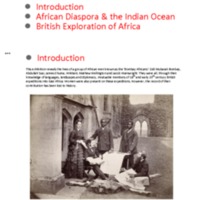
Bombay Africans
Bombay Africans 1850-1910 was exhibited at the Royal Geographical Society as part of the wider ‘Crossing Continents: Connecting Communities’ project, which with community partners aimed to develop new resources to advance the importance of geography. Based on the research of Clifford Pereira and with community consultation partners, Bombay Africans explored the histories of a group of African men who assisted British explorers such as John Hanning Speke, Richard Burton and David Livingstone on mapping expeditions in East Africa in the late 19th century. The name 'Bombay Africans' was given to Africans who had been rescued from the slave ships operating in the Indian Ocean. The exhibition examined the roles of these men in the anti-slavery movement and in Christian organisations like the Church Missionary Society. Focusing on the East Coast of Africa and the slave trade routes in the Indian Ocean, the exhibition also explored enslavement, forced migration, liberation and the African diaspora in the Asian subcontinent.
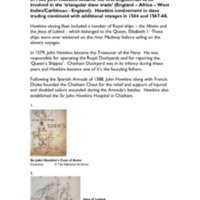
Freedom 1807: The Chatham Dockyard Story
The Historic Dockyard Chatham opened a new exhibition in 2007 to look at the history of Chatham in the context of the transatlantic slave trade. The exhibition examined dockyard ‘founder’ John Hawkins - the leader of the first English expedition to transport West African people to the Americas - the work of Chatham-built ships in policing the slave trade post-abolition, and the hidden history of people from ethnic minorities who served in the Royal Navy or worked in the naval dockyard, from the 18th century to the post-Second World War period. The exhibition also looked at Chatham's links to Indian shipbuilding. HMS Gannet (1878), preserved alongside two other historic warships at The Historic Dockyard, is the only surviving British warship to have taken part in the suppression of the slave trade off the coast Africa during the 19th century. Between 1885 and 1888 Gannet undertook anti-slavery patrols in the Red Sea, intercepting Arab slave traders operating off the East Coast of Africa, around the Gulf and the Indian Ocean.
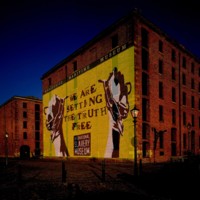
Opening of International Slavery Museum
Liverpool is a port city with a long association with transatlantic slavery. Located on Liverpool's Albert Dock, National Museums Liverpool opened the new International Slavery Museum in 2007, the first stage of a two-part development. The museum aims to promote the understanding of slavery and the transatlantic slave trade and the permanent impact the system has had on Africa, South America, the USA, the Caribbean and Western Europe. It features displays about West African society, the transatlantic slave trade and plantation life, but also addresses issues of freedom, identity, human rights, reparations, racial discrimination and cultural change. The museum also has strong ties with Liverpool’s large Black community. The museum opened on 23 August 2007, designated by UNESCO as Slavery Remembrance Day.
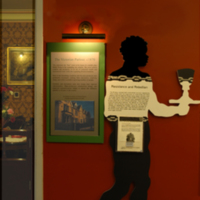
Unfair Trade
York Castle Museum's Unfair Trade exhibition used the museum's collections to explore slavery from the viewpoint of ordinary people, and how consumption of slave-produced everyday commodities - sugar, tea, coffee, cocoa - contributed to the slave trade. It also looked at the part played by York in the abolition of the slave trade and slavery, with the many Quakers of the city supporting William Wilberforce and helping to finance his election campaign. The exhibition continued the focus on consumption into modern life by asking visitors to consider where the products they buy come from. York Castle Museum features a recreated Victorian street, Kirkgate, with its own newspaper, 'The Kirkgate Examiner'. A special edition was distributed to coincide with the exhibition.
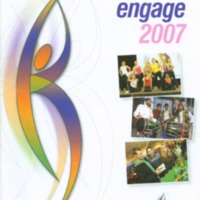
Engage 2007
The Engage 2007 Festival of Culture celebrated cultural freedoms in South Gloucestershire. Led by South Gloucestershire Council, and in partnership with local volunteer groups, schools and community groups, the festival took place on 17 November 2007. It featured 40 live performances of drama, dance and music from India, China, Africa, South America and Europe, a world food zone, family workshops, youth and environmental activities and 60 interactive and information stalls. The Impact exhibition was produced as part of Engage 2007, exploring the part that people living in South Gloucestershire played slavery and abolition.
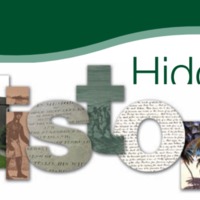
Hidden History of the Dales
This project was a collaboration between the Dales Countryside Museum in Hawes and North Yorkshire Record Office to research people and places of the Yorkshire Dales connected with Africa, the Caribbean and India. 'Hidden History' collected local stories of slave owners and traders, abolitionists, Africans and Asians who moved to the Dales, and others like the actor Ira Aldridge who passed through. The project included various community activities. Working with actor Joe Williams, pupils from the Wensleydale School explored the life of Olaudah Equiano and performed alongside Joe at the exhibition opening. There were drop-in sessions on exploring family history, carnival costume making, talks and music. The exhibition toured to other locations in Yorkshire, including Boroughbridge Library. The Dales Countryside Museum has continued to collect information relating to individuals who were connected with the Yorkshire Dales and the wider world.
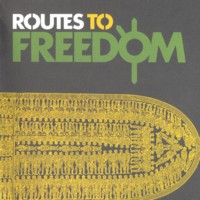
Routes to Freedom
The 'Routes to Freedom' season of events took place throughout Autumn 2007 at The Drum, an intercultural arts venue in Birmingham. The programme explored the struggle for social justice and equality in relation to African, Asian and Caribbean communities, and marked two key historical events and their impact: the bicentenary of the Abolition of the Slave Trade Act and the 60th anniversary of the partition of the Indian subcontinent. The programme was made up of theatre productions, touring exhibitions, film screenings, readings, dance performances and special events, including 'Coolies of the Caribbean' and a conference about Olaudah Equiano.
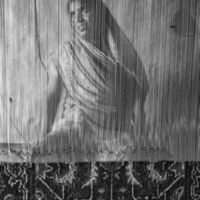
Modern Slavery, Indian Weaver
This image depicts 'Jadawati, a weaver, she is working on a 24 feet carpet which will take her nearly 40 days to complete. As a bonded labourer, she is paid 60 rupees a day, a rate nearly half the minimum wages entitled to her as per the law. The carpet that might sell for 25,000 rupees or more will have earned Jadawati less than 2,500.' The composition of the image gestures towards a sense of imprisonment; the woman is visible behind the fabric weave which acts as an intricate prison. As the rug fabric moves towards completion the figure of Jadawati slowly disappears behind the pattern, as the object of consumption obscures the human cost of production.
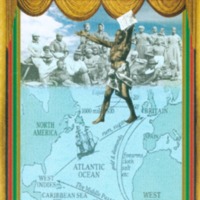
Leeds Bicentenary Transformation Project
This collaborative community initiative celebrated African and Caribbean culture in Leeds, with a focus on commemorating the Abolition Act by 'highlighting African achievement, liberation and aspirations'. New exhibitions, publications and resources were produced and over 100 bicentenary events organised under different themes: Education and Museums; Arts and Carnival Culture; Churches and Abolition; Legacy; Black History and Community Development; Media and Communications. Highlights included the photographic exhibition and pamphlet 'From Abolition to Commonwealth', which remembered indentured labour in Africa and the Caribbean after 1807, and the 40th anniversary of Leeds West Indian Carnival, with themes that highlighted heritage, liberation, respect and freedom. Project outputs included an education pack, black history classes, concerts, church services, lectures and performances.